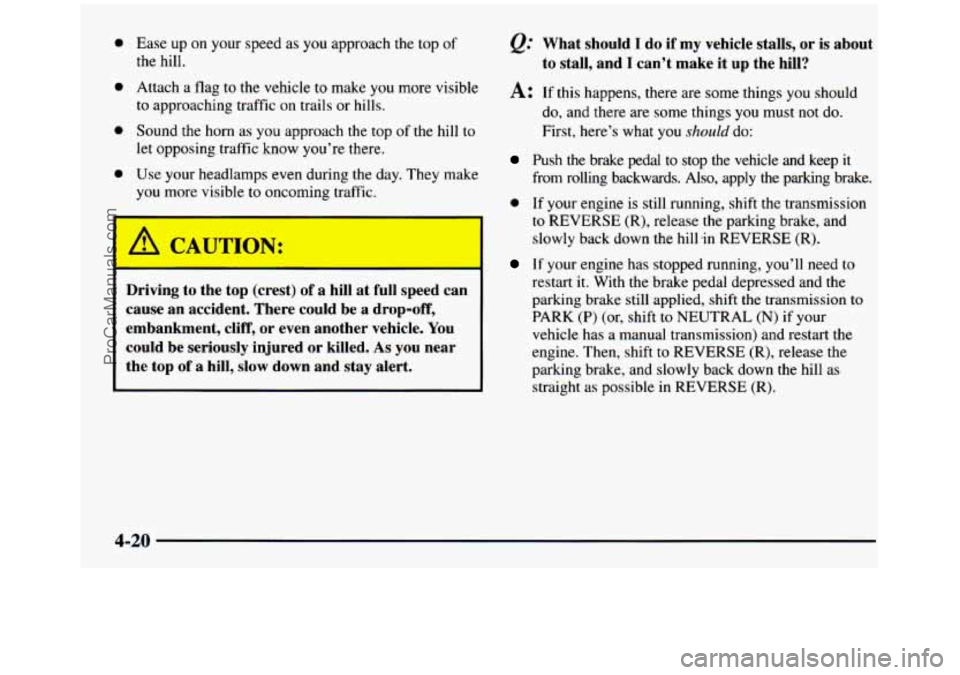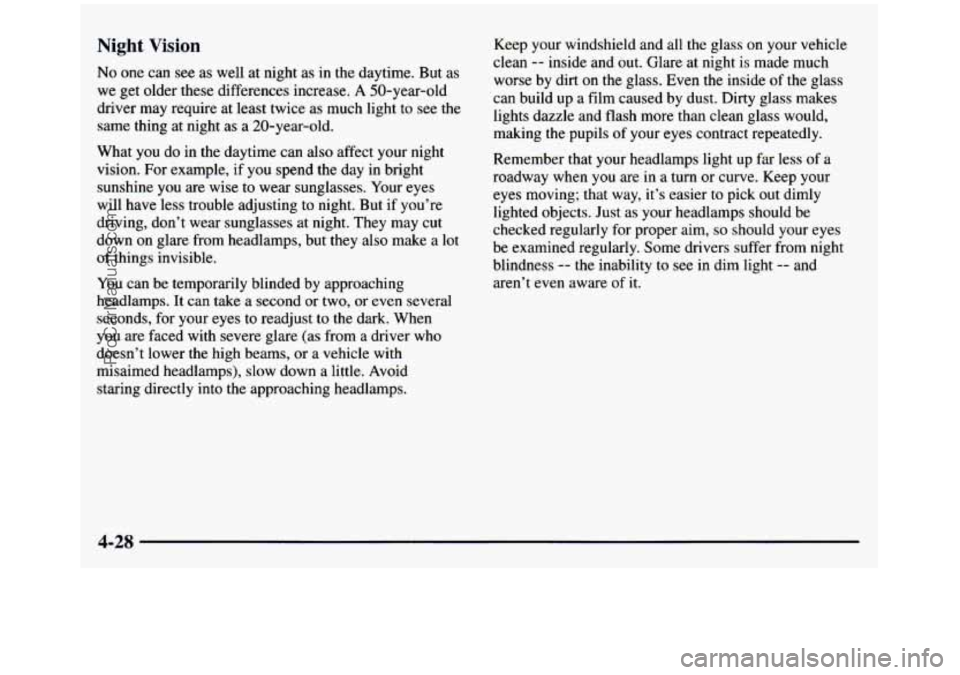Page 122 of 436
Mirrors
Inside Daymight Rearview Mirror
Press or pull the tab under the mirror to reduce glare
from headlamps behind you after dark.
Electrochromic Inside Rearview Mirror
with Compass (If Equipped)
Your vehicle may have an electrochromic inside
rearview mirror.
When on, an electrochromic mirror automatically dims to the proper level to minimize glare from lights behind
you after dark.
The mirror also includes
an eight point compass display
in the upper right corner of the mirror face. When
on,
the compass automatically calibrates as the vehicle
is driven'.
ProCarManuals.com
Page 151 of 436
Daytime Running Lamps Indicator Light
:::O e..
This light goes on whenever
the DRL are
on.
Check Gages Light
I
CHECK
GAGES
This light will come on
briefly when
you are
starting the engine.
When it begins to get dark, the DRL indicator light is a
reminder
to turn on your headlamps.
If the light comes on and stays on while you are driving,
it could indicate a problem with your vehicle. It could be
a problem with your oil pressure, coolant temperature,
or some other problem. Check your various gages
to see
if they are
in the warning zones. If they are, have your
vehicle serviced right
away.
ProCarManuals.com
Page 198 of 436

0
0
0
0
Ease up on your speed as you approach the top of
the hill.
Attach a flag
to the vehicle to make you more visible
to approaching traffic on trails or hills.
Sound the horn as you approach the top of
the hill to
let opposing traffic know you’re there.
Use your headlamps even during the day. They make
you more visible
to oncoming traffic.
J
Driving to the top (crest) of a hill at full speed can
cause an accident. There could be a drop-off,
embankment,
cliff, or even another vehicle. You
could be seriously injured or killed.
As you near
the top
of a hill, slow down and stay alert.
@ What should I do if my vehicle stalls, or is about
A: If this happens, there are some things you should
to stall, and I can’t make it up the hill?
do, and there are some things you must not do.
First, here’s what you
should do:
Push the brake pedal to stop the vehicle and keep it
from rolling backwards. Also, apply
the parking brake.
0 If your engine is still running, shift the transmission
to REVERSE
(R), release the parking brake, and
slowly back down the
hill in REVERSE (R).
If your engine has stopped running, you’ll need to
restart it.
With the brake pedal depressed and the
parking brake still applied, shift the transmission
to
PARK (P) (or, shift to NEUTRAL (N) if your
vehicle has a manual transmission) and restart
the
engine. Then, shift to REVERSE (R), release the
parking brake,
and slowly back down the hill as
straight as possible in REVERSE
(R).
4-20
ProCarManuals.com
Page 205 of 436
Driving at Night
....... .^ .... ......................... ." ....................... I .........................
Night driving is more dangerous than day driving.
One reason is that some drivers are likely to be
impaired
-- by alcohol or drugs, with night vision
problems, or by fatigue. Here are some tips on night driving.
0
0
0
0
0
0
0
Drive
defensively.
Don't drink and drive.
Adjust your inside rearview mirror to reduce the
glare from headlamps behind you.
Since
you can't see as well, you may need to slow
down and keep more space between you and
other vehicles.
Slow down, especially on higher speed roads.
Your
headlamps can light up only so much road ahead.
In remote areas, watch for animals.
If you're tired, pull off the road in
a safe place
and rest.
4-27
.... I..
ProCarManuals.com
Page 206 of 436

Night Vision
No one can see as well at night as in the daytime. But as
we get older these differences increase. A 50-year-old
driver may require at least twice as much light to see the
same thing at night as
a 20-year-old.
What you do in the daytime can also affect your night
vision. For example, if you spend the day in bright
sunshine you are wise to wear sunglasses. Your eyes
will have less trouble adjusting to night. But if you’re
driving, don’t wear sunglasses at night. They may cut
down on glare from headlamps, but they also make a lot
of things invisible.
You can be temporarily blinded by approaching
headlamps.
It can take a second or two, or even several
seconds, for your eyes
to readjust to the dark. When
you
are faced with severe glare (as from a driver who
doesn’t lower the high beams, or a vehicle with
misaimed headlamps), slow down
a little. Avoid
staring directly into the approaching headlamps. Keep your windshield and all the glass on your vehicle
clean
-- inside and out. Glare at night is made much
worse by dirt on the glass.
Even the inside of the glass
can build up a film caused by dust. Dirty glass makes lights dazzle and flash more than clean glass would,
making the pupils of your eyes contract repeatedly.
Remember that your headlamps light up far less of a
roadway when you
are in a turn or curve. Keep your
eyes moving; that way, it’s easier
to pick out dimly
lighted objects. Just as your headlamps should be
checked regularly for proper aim,
so should your eyes
be examined regularly. Some drivers suffer from night
blindness
-- the inability to see in dim light -- and
aren’t even aware
of it.
4-28
ProCarManuals.com
Page 218 of 436

- -
A CAJTldN:
Snow can trap exhaust gases under your vehicle.
This can cause deadly
CO (carbon monoxide) gas
to get inside.
CO could overcome you and kill
you. You can’t see it or smell it,
so you might not
know
it is in your vehicle. Clear away snow from
around the base of your vehicle, especially
any
that is blocking your exhaust pipe. And check
around again from time to time to be sure snow
doesn’t collect there.
Open
a window just a little on the side of the
vehicle that’s away from the wind. This will help
keep
CO out. Run your engine
only as long as you must. This saves
fuel. When you run the engine, make
it go a little faster
than just idle. That is, push the accelerator slightly.
This uses less fuel for the heat that you get and
it
keeps the battery (or batteries) charged. You will need a
well-charged battery (or batteries) to restart
the vehicle,
and possibly for signaling later on with your headlamps.
Let the heater run for awhile.
If you have
a diesel engine, you may have to run it at a
higher speed to get enough heat. Then, shut the engine
off and close the window almost all the way to preserve
the heat. Start
the engine again and repeat this only
when
you feel really uncomfortable from the cold. But
do it as little as possible. Preserve the fuel as long as
you
can. To help keep warm, you can get out of the vehicle
and do some fairly vigorous exercises every half hour
or
so until help comes.
4-40
ProCarManuals.com
Page 316 of 436
Headlamps
Sealed Beam Lamps
1. Remove the
four screws from the
headlamp retainer.
4. Plug in the new headlamp and put it in place.
5. Install the retainer to the headlamp and tighten
the screws.
2. Pull the headlamp out and remove the retainer.
6-40
ProCarManuals.com
Page 317 of 436
Composite Headlamps
1. Remove the two screws
at the top
of the
radiator support.
2. Pull the headlamp lens assembly out.
3. Unplug the electrical connector.
4. Turn the bulb
counterclockwise and remove it.
5. Put the new bulb into the lens assembly and turn it to
6. Plug in the electrical connector.
the
right until it
is tight.
7. Put the headlamp lens assembly back into the
vehicle. Install and tighten
the two screws.
ProCarManuals.com